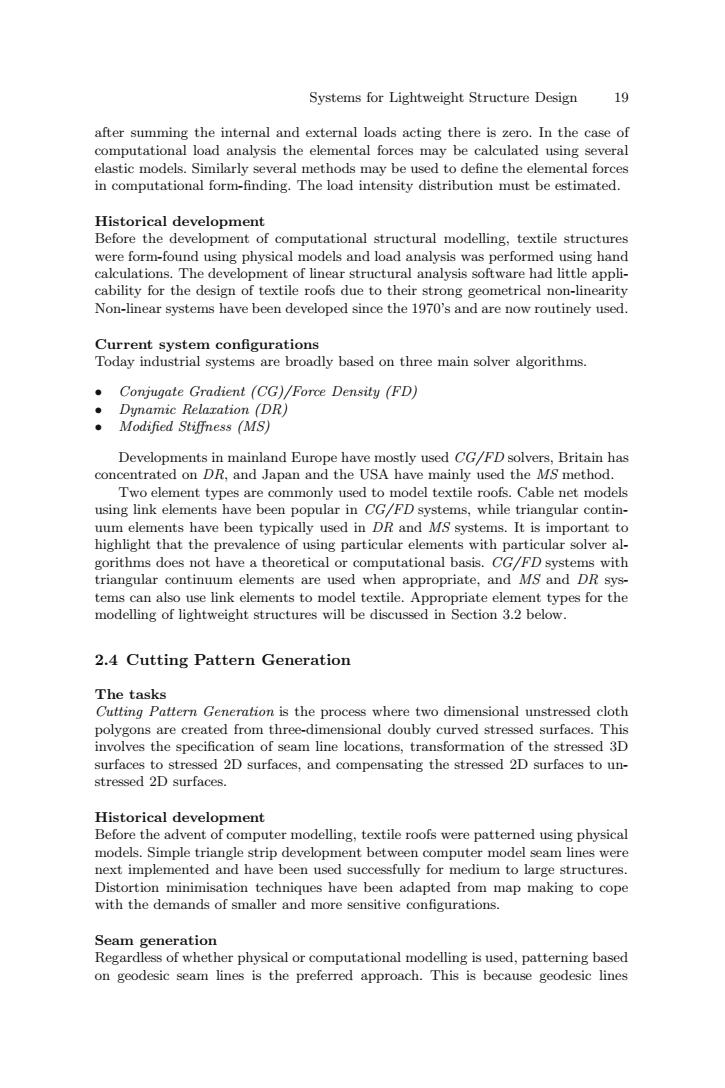正在加载图片...

Systems for Lightweight Structure Design 19 after summing the internal and external loads acting there is zero.In the case of computational load analysis the elemental forces may be calculated using several elastic models.Similarly several methods may be used to define the elemental forces in computational form-finding.The load intensity distribution must be estimated. Historical development Before the development of computational structural modelling,textile structures were form-found using physical models and load analysis was performed using hand calculations.The development of linear structural analysis software had little appli- cability for the design of textile roofs due to their strong geometrical non-linearity Non-linear systems have been developed since the 1970's and are now routinely used. Current system configurations Today industrial systems are broadly based on three main solver algorithms. Conjugate Gradient (CG)/Force Density (FD) Dynamic Relaration (DR) Modified Stiffness (MS) Developments in mainland Europe have mostly used CG/FD solvers,Britain has concentrated on DR,and Japan and the USA have mainly used the MS method. Two element types are commonly used to model textile roofs.Cable net models using link elements have been popular in CG/FD systems,while triangular contin- uum elements have been typically used in DR and MS systems.It is important to highlight that the prevalence of using particular elements with particular solver al- gorithms does not have a theoretical or computational basis.CG/FD systems with triangular continuum elements are used when appropriate,and MS and DR sys- tems can also use link elements to model textile.Appropriate element types for the modelling of lightweight structures will be discussed in Section 3.2 below. 2.4 Cutting Pattern Generation The tasks Cutting Pattern Generation is the process where two dimensional unstressed cloth polygons are created from three-dimensional doubly curved stressed surfaces.This involves the specification of seam line locations,transformation of the stressed 3D surfaces to stressed 2D surfaces,and compensating the stressed 2D surfaces to un- stressed 2D surfaces. Historical development Before the advent of computer modelling,textile roofs were patterned using physical models.Simple triangle strip development between computer model seam lines were next implemented and have been used successfully for medium to large structures. Distortion minimisation techniques have been adapted from map making to cope with the demands of smaller and more sensitive configurations. Seam generation Regardless of whether physical or computational modelling is used,patterning based on geodesic seam lines is the preferred approach.This is because geodesic linesSystems for Lightweight Structure Design 19 after summing the internal and external loads acting there is zero. In the case of computational load analysis the elemental forces may be calculated using several elastic models. Similarly several methods may be used to define the elemental forces in computational form-finding. The load intensity distribution must be estimated. Historical development Before the development of computational structural modelling, textile structures were form-found using physical models and load analysis was performed using hand calculations. The development of linear structural analysis software had little applicability for the design of textile roofs due to their strong geometrical non-linearity Non-linear systems have been developed since the 1970’s and are now routinely used. Current system configurations Today industrial systems are broadly based on three main solver algorithms. • Conjugate Gradient (CG)/Force Density (FD) • Dynamic Relaxation (DR) • Modified Stiffness (MS) Developments in mainland Europe have mostly used CG/FD solvers, Britain has concentrated on DR, and Japan and the USA have mainly used the MS method. Two element types are commonly used to model textile roofs. Cable net models using link elements have been popular in CG/FD systems, while triangular continuum elements have been typically used in DR and MS systems. It is important to highlight that the prevalence of using particular elements with particular solver algorithms does not have a theoretical or computational basis. CG/FD systems with triangular continuum elements are used when appropriate, and MS and DR systems can also use link elements to model textile. Appropriate element types for the modelling of lightweight structures will be discussed in Section 3.2 below. 2.4 Cutting Pattern Generation The tasks Cutting Pattern Generation is the process where two dimensional unstressed cloth polygons are created from three-dimensional doubly curved stressed surfaces. This involves the specification of seam line locations, transformation of the stressed 3D surfaces to stressed 2D surfaces, and compensating the stressed 2D surfaces to unstressed 2D surfaces. Historical development Before the advent of computer modelling, textile roofs were patterned using physical models. Simple triangle strip development between computer model seam lines were next implemented and have been used successfully for medium to large structures. Distortion minimisation techniques have been adapted from map making to cope with the demands of smaller and more sensitive configurations. Seam generation Regardless of whether physical or computational modelling is used, patterning based on geodesic seam lines is the preferred approach. This is because geodesic lines